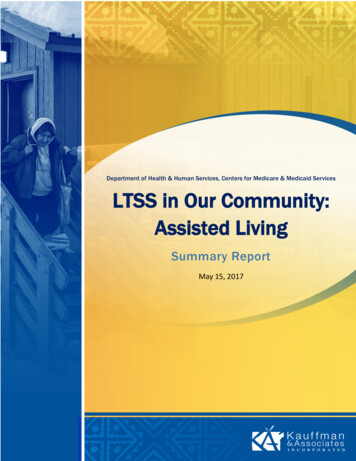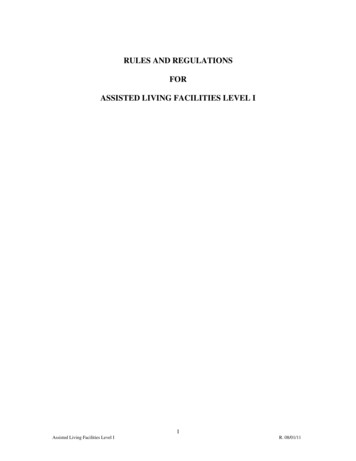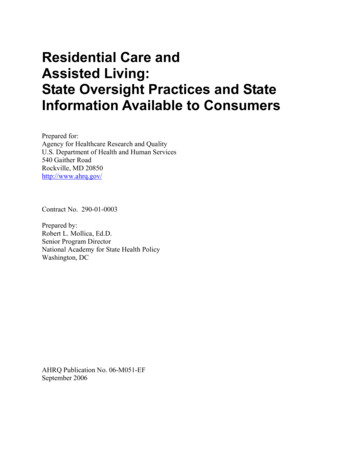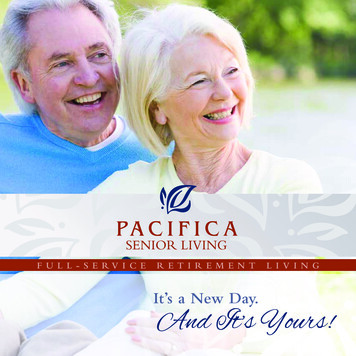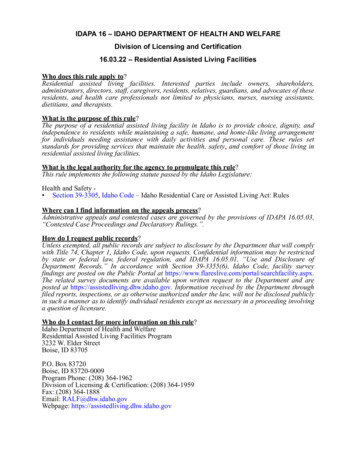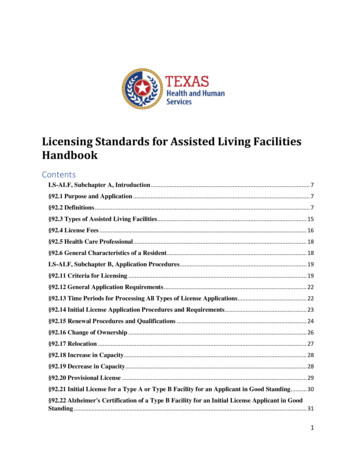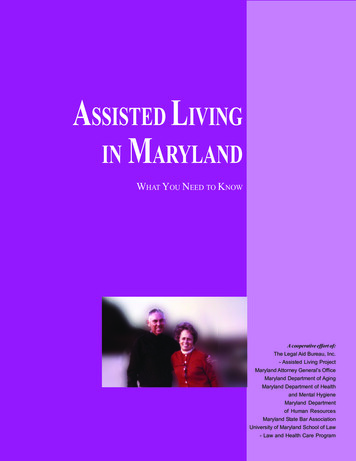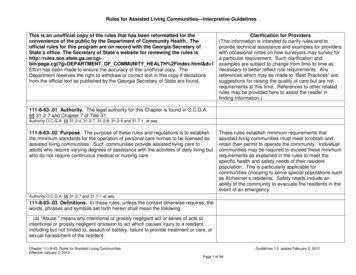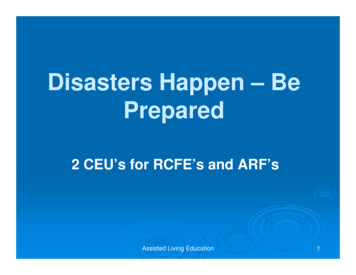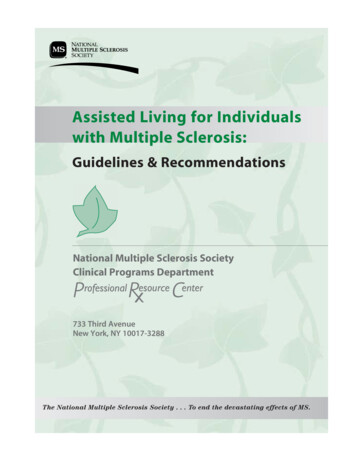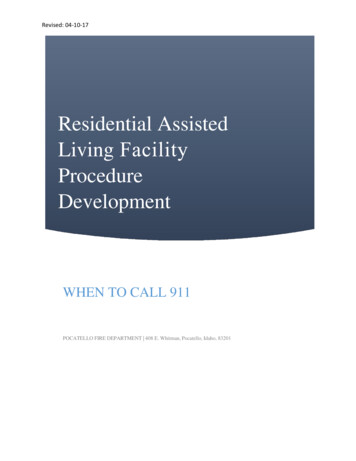
Transcription
Revised: 04-10-17Residential AssistedLivingProcedureDevelopmentWHEN TO CALL 911POCATELLO FIRE DEPARTMENT 408 E. Whitman, Pocatello, Idaho, 83201
Revised: 04-10-17Table of ContentsPurpose of this Document . 1Determine Medical Need . 2Things to consider . 3Events to consider 911 . 4Accessing 911. 10What to do before the ambulance arrives. . 11Amendment Process . 12Appendix A. 13
Purpose of this DocumentIn order to ensure efficient and effective care, streamline the process, and to ensure the availability ofscarce emergency resources, the Pocatello Fire Department, in conjunction with numerous residentialassisted living facilities has developed a series of guideline’s, decision making trees, and protocols.The intention is to empower the residential assisted living facility staff by providing tools, training,and guidance to analyze an event and to make a decision whether to call 911 or not.The fire department has a vested interest in a well-trained aide who makes appropriate decisions,that is why we have taken the initiative to bring the players together and invest time in ourcommunity. This document is not intended to be a series of instructions or demands from the FireDepartment. This is a consensus document intended to be a resource for the facility nurse to usewhile training staff. In essence it is a guide for all of the residential assisted living facilities in thecommunity to seamlessly communicate and interact with the emergency responders, and to create afeedback loop for system, and document improvements.According to Idaho Administrative Procedures Act (IDAPA) the facility needs to have a nurseavailable 24-7. The nurse can train staff to take vitals and do range of motion (ROM), so that when aneed arises, the staff can report to the nurse over the phone to help the nurse make a determination ifEMS should be called. The facility should not be skipping over this step and relying on EMS toprovide that initial assessment. If EMS is not called, then the nurse will need to do an in-personassessment. The timing of this assessment depends on the incident, the resident, their health status,what the potential issue is, and the nurse's judgment.1
Determine Medical NeedIt is important to note that every patient in a residential assisted living facility is directly under thecare of a physician. Each facility also has a registered nurse who is responsible for the patients aswell. While this does not prevent anyone from calling 911, it does provide an obligation for the RNto obtain guidance and orders from the physician.For all life threatening emergencies of non-terminal patients the provider should call 911immediately and then notify the facility nurse. If the emergency is related to the terminalcondition, then the provider should notify the facility nurse and Administration, MD, HH orHospice as appropriate, follow their instructions.For all non-life threatening situations, including any falls, the facility should contact thefacility nurse for direction.Sometimes facilities get into trouble if they are having staff call the hospice or home health fordirection when a resident falls and the facility RN is not aware of the situation. If the emergency isrelated to the terminal condition, then it would be appropriate for staff to contact the hospice nursefirst, and then make sure the facility RN was also aware. For all other situations, including any falls,the facility should contact the facility nurse for direction. Some facilities have also had difficultywhen the administrator or other non-licensed staff member was the person being called and makingthe assessment determination rather than the licensed nurse.Every patient, or medical power of attorney, has the Right to seek medical attention from someoneother than their primary care physician (PCP), but it is highly encouraged to utilize the PCP. Thisreduces the confusion of multiple care givers, lost discharge papers, and improves continuity of care.Equally important is that every patient who has not been deemed incompetent by a Court has theright to refuse examination, treatment or transport. The fire department/Bannock County AmbulanceCANNOT assess, provide medical care or transport a patient against their will. Everyone has theRight to make their own healthcare choices, this included refusal of care. A patient who has assigneda power of attorney has not lost their right to refuse care, unless deemed incompetent by a Court. Apower of attorney is simply a legal document that gives someone the patient chooses the power toact in their place, in case they ever become mentally incapacitated.Key QuestionsDoes patient desire EMS assessment or transport?Does event require immediate emergency intervention by a higher level of care?Could the patient be monitored for the next several hours and then evaluated by RN?2
Things to considerMedicare does not pay for ambulance service that is not medically necessary or for theconvenience of a patient, family, facility or physician. An example of this is that a patient who wassent to the hospital via ambulance for altered mental status, may not be eligible to be transportedback to the facility by ambulance once the diagnosis of a UTI has been made. If Medicare doesn’tpay for the ambulance services below, the patient, or the facility may be obligated to pay.Medicare does not pay for everything, even some care that the health care provider has goodreason to think the patient may need. In order to have this discussion prior to the patient acceptingtransport and then ending up stuck with the bill, Medicare has provided the Pocatello FireDepartment/Bannock County Ambulance with an Advance Beneficiary Notice of Non-coverage(ABN) Appendix A. This document must be signed prior to any non-emergent transport. It statesthat we expect Medicare may not pay for the ambulance services listed below: Medicare does not pay for transportation from a residence or a facility for services thatcould more economically be performed at the residence or facilityo Medicare does not pay for ambulance service that is not medically necessaryo (Example) Transportation back to the facility for an ambulatory patient that could sit ina non-emergency vehicle.Medicare does not pay for transports to a doctor’s office or other non-covered Destinationso (Example) Transportation to the hospital for a urinalysis, when a urinalysis could beconducted at the facility.(Example) Ambulance transports to locations other than the emergency department aremost likely not coveredMedicare does not pay for mileage beyond the closest appropriate facilityo(Example) Ambulance transports to locations other than Portneuf Medical Center aremost likely not covered Medicare does not pay for transports for the convenience of a patient, family, facility, orphysician Medicare does not pay for wheelchair van or stretcher car servicesoThe Pocatello Fire Department/Bannock County Ambulance does not offer this service.3
Events to consider 911Obvious DeathDefinition: Obvious clinical signs of irreversible death such as:Dependent lividity of any degree: indicating that the body has been pulseless and in the sameposition long enough for blood to sink and collect within the body, creating purplishdiscolorations at the lowest points of the body (with respect to gravity).Rigor mortis: indicating that the patient has been dead for at least a few hours.**Follow facility protocols**DO NOT contact 911. Notify facility nurse, follow their instructions.Law enforcement does not need to be notified for patients that are in a medical facility, andunder the care of a physician, that appear to have died from medically related problems,unless the need for investigation is determined by staff.Law enforcement should be contacted for obviously suspicious circumstances and coronershould be contacted for deaths with unexpected external causes. (208)243-1328Cardiac ArrestDefinition: An unexpected loss of heart function, breathing and consciousness.Initiate CPR protocolsIs patient a DNR? Confirm POST Form instructions regarding DNR and comfort measurestatus. (Ideally it is desired for staff to remember each patient’s status)If DNR, respect patient/families intent. Stop CPR and allow peaceful death. Prepare tocomfort family and/or staff. (See Obvious Death)If NO DNR Call 911Notify facility nurse and follow their instructions.4
5
Shortness of BreathDefinition: Severe difficulty in achieving adequate oxygenation in spite of significant effortsto breathe. It is usually associated with increased breathing rate and the use of accessorymuscles in the chest wall.Is patient a DNR? Confirm POST Form instructions regarding DNR and comfort measurestatus. (Ideally it is desired for staff to remember each patient’s status)If DNR, respect patient/families intent. Stop CPR and allow peaceful death. Prepare tocomfort family and/or staff. (See Obvious Death)If NO DNR Call 911Open airway, prevent positional asphyxia.If allowed, place patient on oxygen. DO NOT LEAVE PATIENT UNATTENDED! CALLFOR HELP! Monitor and prepare for respiratory/cardiac arrest. Notify facility nurse andfollow their instructions.See the Interact guidelines http://interact2.net/IllnessDefinition: An unhealthy condition of the body.Notify facility nurse and follow their instructions.See the Interact guidelines http://interact2.net/Acute Mental Status ChangeDefinition: A change in awareness of a person's surroundings and/or impaired mentalfunctioning.Consider 911 for Physical symptoms along with altered mental status that is a deviationfrom the patient’s baseline mental status Consider the possibility of a stroke.Notify facility nurse and follow their instructions.See the Interact guidelines http://interact2.net/6
Hip Pain After a Traumatic EventDefinition: New pain in the hip/pelvic/upper thigh area after a traumatic event, such as afall, that causes pain during sitting, movement or standing up.Allow patient to seek position of comfort. Patient should not be restricted from voluntarymovement to a sitting position or from movement to a bed.Do not prevent patient from seeking different position to prevent difficulty of breathing.Cover patient with a blanket to reduce heat loss.Attempt to place a blanket under the patient to provide padding and to facilitate patientmovement. Place pillow under patient’s head. It is anticipated that the most comfortableposition for the patient will be in their bed, on a couch or in a recliner. HOWEVER, ifpatient complains of pain during movement, STOP! Reconsider decision to move patient.Stay with patient when calling 911.Notify facility nurse and follow their instructions.See the Interact guidelines http://interact2.net/FallDefinition: to descend freely by the force of gravity, to leave an erect position suddenly andinvoluntarily.From Standing Forward/BackwardObserve for head injury. Common signs/symptoms:HeadacheNausea or vomitingFatigue or drowsinessDizziness or loss of balanceDid patient lose consciousness?Are there any marks on the resident head, fluid from ears/nose, pupils equal, complaining ofneck pain?Is there any new extremity pain, swelling, deformity, discoloration, vomiting, slurred speech(if normally understood), seizures, chest pain, shortness of breath, right or left sidedweakness, facial drooping?If yes, Call 911If NO, Are there any wounds? Bruises, skin tears, rug burns, or red marks?Obtain VS, requisite documentation. Notify facility nurse and follow their instructions.See the Interact guidelines http://interact2.net/7
From Sitting/Bed Forward onto face or upper torsoObserve for head injury. Common signs/symptoms:HeadacheNausea or vomitingFatigue or drowsinessDizziness or loss of balanceDid patient lose consciousness?Are there any marks on the resident’s head, fluid from ears/nose, pupils equal, complainingof neck pain?Is there any new extremity pain, swelling, deformity, discoloration, vomiting, slurred speech(if normally understood), seizures, chest pain, shortness of breath, right or left sidedweakness, facial drooping?If yes, Call 911If NO, Are there any wounds? Bruises, skin tears, rug burns, or red marks?Obtain VS, requisite documentation. Notify facility nurse and follow their instructions.See the Interact guidelines http://interact2.net/Slid from Chair/Bed to floorThis is not a fall, confirm lack of injuries, assist patient back to chair and documentappropriately.8
NO9
Accessing 911The City of Pocatello utilizes a computer aided dispatch program for emergency medical dispatching.This program, called ProQA, directs our certified Emergency Medical Dispatchers to ask a series ofquestions to quickly and accurately determine the best response for the emergency.With each call to 911, our goal is to create a quick and proper response for the emergency medicalneed, also, to reduce the risk to the public and emergency vehicles responding to the scene. The information needed when a call is placed to 911 is: What the address of the emergency is? The phone number of the caller, in case of disconnection? Exactly what happened in a short or condensed manner? Is the caller near the patient? The number of patients? The age of the patient if it is known or approximation? If the patient is awake or not? If the patient is breathing or not? Provide dispatcher with door code if neededAfter these few questions are answered, and based on the nature of the emergency, 911 can dispatchthe proper response and personnel to the address of the emergency. Additional questions may beasked based on the nature of emergency, and instructions on what to do until ems arrives will begiven, if needed.10
What to do before the ambulance arrives.UNLOCK THE DOORS!Have staff member stand by to offer directions.Continue to monitor patient.Provide necessary interventions.Obtain vital signs (if able):PulseRespirationsSPO2 if within scope of practiceBlood PressureBlood GlucoseRequired/Desired PaperworkDocumentWhy1 FacesheetName/birthday2 Staff (someone who knows why we are beingcalled)/location3 Idaho Physicians Order for Scope of Treatment(POST)/DNR4 Medication administration record (MAR’s)Directions to patient and issue (sometimes notwhy we were dispatched)Patient and family wishes5 Hospice status and for what reasonHas hospice been notified?6 Recent history and physicalChanges due to age, Acute vs. Chronic7 Current diagnosisAids in our evaluation of the patient8 Vital signsCurrent status/initiate baseline Vital signs9 Pertinent paperwork for the hospitalEasier to give to them rather than fax later10 Power of attorney paperworkHave they been contacted/ their decision oftransport or no transportHistory of UTI’s? Antibiotics?11
Amendment ProcessThis document is intended to never be finalized. It will be reviewed on an ongoing basis and whendeemed appropriate by its stakeholders and signatories, shall be modified and updated to fit the scopeof the current need. Any stakeholder or signatory can offer up suggested language to be agreed uponat any of our future meetings. The stakeholder shall identify a problem, develop the desired languageto address the issue and send it out to all members for review. If it is a time sensitive concern, ameeting may be scheduled prior to the intended quarterly meeting.12
Appendix ARulesCore 520 - 011.08 -definition of inadequate care - When a facility fails to provide the servicesrequired to meet the terms of the negotiated service agreement (NSA), or provide for room, board,activities of daily living, supervision, first aid, assistance and monitoring of medications, emergencyinterventions, coordination of outside services, a safe living environment or engages in violation ofresidents rights or takes residents who have been admitted in violation of provisions of section 3933-7, Idaho CodeCore 525 - 011.24, definition of neglect – Failure to provide food, clothing, shelter, or medical carenecessary to sustain the life and health of a resident.Nursing rules: 300-Nursing services must be performed in accordance with IDAPA 23.01.01, Rulesof the Idaho Board of Nursing. The facility must have on staff or under contract the nursingpersonnel listed in subsection 300.01 and 300.02 of these rules to provide nursing servicerequirements.300.1 –A licensed professional nurse (RN) must visit the facility at least once every ninety (90)days or when there is a change in the resident’s condition 300.2 – The facility must assure that a licensed nurse is available to address changes in theresident’s health or mental status and . . . .305- The licensed professional nurse must assess and document, including date and signature, foreach resident as described in subsections 305.01 through 305.08 of these rules.305.03- Conduct a nursing assessment of the health status of each resident by identifying symptomsof illness or changes in mental or physical health status.711.8.e – There must be documentation of the “notification of the licensed professional nurse of achange in the resident’s physical or mental condition; and .13
Frequently Asked QuestionsReceived from Simpson, Jamie L. - Licensing & Certification, 10/23/2015Is a person who needs a two-person assist with They can be, but the facility would have totransfers appropriate for admission to ahave at least 2 staff on around the clock toRALF?provide the assistance. (12/8/08)If a hospice resident has blackout episodes Not if the facility has written parameters fromthat are a part of their disease process does 911 the physician describing when 911 should not behave to be called?called. (4/2/07)Families have sometimes become angrywhen 911 was called. What should we doabout this?The facility should disclose to families duringthe admission process what level of nursing thefacility has in the building and that when thereis not a nurse in the building, then 911 will becalled, as facility staff cannot assess residents.Ultimately, the facility is responsible forensuring the residents are provided thenecessary medical care. (7/15/09)When a resident falls we were recently toldthat the nurse first had to assess them beforethey were helped up from the floor. Is itpossible for it to be a phone assessment bythe nurse or do they need to come in?Our nurse has instructed the staff to ask theresident to do various ROM tasks to determineif an unobvious fracture is present. She wouldbe happy to do this over the phone but wasunaware that she needed to come in for everyfall.Unlicensed Caregivers can be trained to takevitals and direct the resident in ROM tasks.The nurse would need to provide face to facetraining for staff and document the delegation.When called, the nurse could determine, basedon the resident and the information reported bystaff, if 911 needed to be called. If 911 wasnot called, the nurse should come in and do anassessment to ensure the resident isok.(6/11/07)Are assisted living facilities required to have a IDAPA 16.03.22.300.02. Licensed Nurse. Thenurse on call 24-7?facility must assure that a licensed nurse isavailable to address changes in the resident'shealth or mental status and to review andimplement new orders prescribed by theresident's health care provider. (7/19/06)14
Bannock County Ambulance District408 E Whitman, Pocatello, ID 83201 Phone: (208) 234-6200 Fax: (208) 233-4043Patient Name:Incident Number:Advance Beneficiary Notice of Noncoverage (ABN)NOTE: If Medicare doesn’t pay for the ambulance services below, you may have to pay.Medicare does not pay for everything, even some care that you or your health care provider havegood reason to think you need. We expect Medicare may not pay for the ambulance services listed below.ServicesReason Medicare May Not Pay:Ambulance transportand mileageAmbulance mileageNonAmbulanceServicesEstimated CostMedicare does not pay for transportation from a residence or a SNF forservices that could more economically be performed at the residence or SNFMedicare does not pay for ambulance service that is not medically necessaryMedicare does not pay for transports to a doctor’s office or other non-covereddestinationsMedicare does not pay for transports for the convenience of a patient, familyor physicianMedicare does not pay for mileage beyond the closest appropriate facilityMedicare does not pay for wheelchair van or stretcher car servicesBLS Ambulance Service: 440 (BannockCounty Resident)or 660 (non-resident)ALS Ambulance Service: 520 (BannockCounty Resident)or 780 (non-resident) 10 per mileWHAT YOU NEED TO DO NOW: Read this notice, so you can make an informed decision about your care. Ask us any questions that you may have after you finish reading. Choose an option below about whether to receive the ambulance services listed above.Note: If you choose Option 1 or 2, we may help you to use any other insurance that you might have, but Medicare cannot requireus to do this.Check only one box. We cannot choose a box for you.OPTION 1. I want the ambulance services listed above. You may ask to be paid now, but I also wantMedicare billed for an official decision on payment, which is sent to me on a Medicare Summary Notice (MSN). Iunderstand that if Medicare doesn’t pay, I am responsible for payment, but I can appeal to Medicare byfollowing the directions on the MSN. If Medicare does pay, you will refund any payments I made to you, less copays or deductibles.OPTION 2. I want the ambulance services listed above, but do not bill Medicare. You may ask to be paidnow as I am responsible for payment. I cannot appeal if Medicare is not billed.OPTION 3. I don’t want the ambulance services listed above. I understand with this choice I am notresponsible for payment, and I cannot appeal to see if Medicare would pay.H. Additional Information:This notice gives our opinion, not an official Medicare decision. If you have other questions on this notice or Medicare billing, call 1800-MEDICARE (1-800-633-4227/TTY: 1-877-486-2048).Signing below means that you have received and understand this notice. You also receive a copy.I. Signature:J. Date:According to the Paperwork Reduction Act of 1995, no persons are required to respond to a collection of information unless it displays a valid OMB control number. The valid OMB control number for this informationcollection is 0938-0566. The time required to complete this information collection is estimated to average 7 minutes per response, including the time to review instructions, search existing data resources, gather the data needed,and complete and review the information collection. If you have comments concerning the accuracy of the time estimate or suggestions for improving this form, please write to: CMS, 7500 Security Boulevard, Attn: PRAReports Clearance Officer, Baltimore, Maryland 21244-1850.15
EMERGENCY ROOM/INPATIENT REFERAL FORMToday’s Date:PCP:Patient’s last name:Does Patient have a MedicalPower of AttorneyYesFirst:If so, what is their name?PATIENT INFORMATIONMiddle:Power of Attorney contact informationBirth date:Age:Sex:MNoFSocial Securityno.: [SS#]Facility Name and Address: [Address/ P.O Box, City, ST ZIP Code]Transportation to ED:⃝Facility Bus⃝Private Vehicle⃝ AmbulanceTransportation from ED:⃝Facility Bus⃝Private Vehicle⃝ AmbulanceMedicare does not pay for ambulance service that is not medically necessary or for the convenience of a patient, family, facility or physicianReason for ER Visit: include date of onset, present treatment, history of illness, include all x-ray’s and lab results with consultation.16
Current Medications: SEE MAR or LISTAllergies: See Medical records or LISTVital Signs:BPTSPO2GlucosePlease attach actual Emergency Room recordsSignificant findings, including tests done:DiagnosisOrders/RecommendationsER Physicians Signature:DatePlease include copy of ER Discharge Summary upon releaseQA document17
assisted living facilities has developed a series of guideline’s, decision making trees, and protocols. The intention is to empower the residential assisted living facility staff by providing tools, tra
